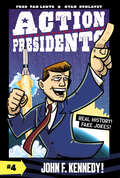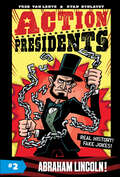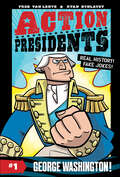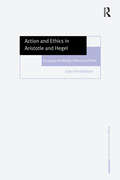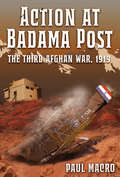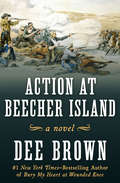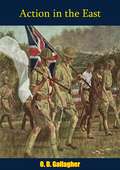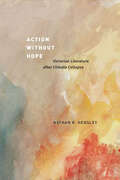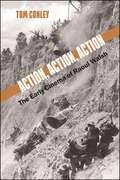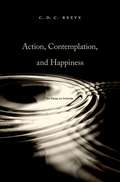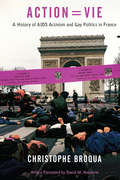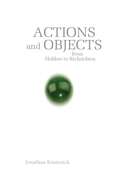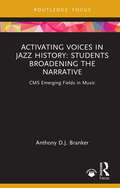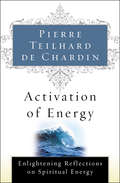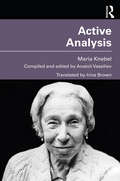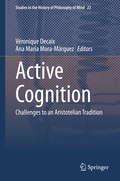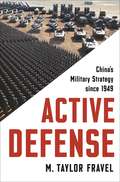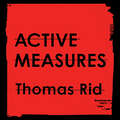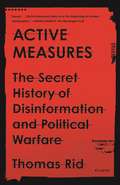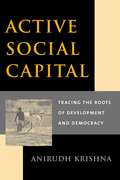- Table View
- List View
Action Presidents #4: John F. Kennedy! (Action Presidents #4)
by Fred Van Lente“A delightful, educational spin on history—and plenty of jokes,” said School Library Journal. “Sheer joy,” praised Booklist in a starred review. Finalist for the 2019 Excellence in Graphic Literature Award in Middle Grade Nonfiction U.S. history comes to life like never before in this full-color graphic novel! We all know that John F. Kennedy was a World War II hero and a pro at giving speeches. But did you also know he survived shark-infested waters, suffered a case of mistaken identity, and once used a coconut to send a secret message? Wimpy Kid meets the Who Was... series in these hilarious new graphic novels—where the history is real and the jokes are fake—from New York Times bestselling comic book author Fred Van Lente and award-winning cartoonist Ryan Dunlavey. Historically accurate and highly entertaining, Action Presidents’ bold and hilarious comic-style illustration is perfect for curious minds, filled with timelines, maps, charts, and more, readers will keep learning until the last page.
Action Presidents: Abraham Lincoln! (Action Presidents #2)
by Fred Van Lente“A delightful, educational spin on history—and plenty of jokes,” said School Library Journal. “Sheer joy,” praised Booklist in a starred review.Finalist for the 2019 Excellence in Graphic Literature Award in Middle Grade NonfictionU.S. history comes to life like never before in this full-color graphic novel! We all know that Abraham Lincoln gave the historic Gettysburg Address and ended the Civil War. But did you also know that he never went to college, was a licensed bartender, and kept important documents in his famous top hat?Wimpy Kid meets the Who Was... series in these hilarious new graphic novels—where the history is real and the jokes are fake—from New York Times bestselling comic book author Fred Van Lente and award-winning cartoonist Ryan Dunlavey. Historically accurate and highly entertaining, Action Presidents’ bold and hilarious comic-style illustration is perfect for curious minds, filled with timelines, maps, charts, and more, readers will keep learning until the last page.
Action Presidents: George Washington! (Action Presidents #1)
by Fred Van Lente“A delightful, educational spin on history—and plenty of jokes,” said School Library Journal.“Sheer joy,” praised Booklist in a starred review.Finalist for the 2019 Excellence in Graphic Literature Award in Middle Grade NonfictionU.S. history comes to life like never before in this full-color graphic novel! We all know that George Washington was our first President and a hero of the American Revolution. But did you also know that he didn’t want to be president, never thought he would fight in a war, and had teeth so bad that he hated to smile?Wimpy Kid meets the Who Was... series in these hilarious new graphic novels—where the history is real and the jokes are fake—from New York Times bestselling comic book author Fred Van Lente and award-winning cartoonist Ryan Dunlavey.Historically accurate and highly entertaining, Action Presidents’ bold and hilarious comic-style illustration is perfect for curious minds, filled with timelines, maps, charts, and more, readers will keep learning until the last page.
Action Research and Critical Psychology: An Investigation of Subjectivity and Participation (Theory and History in the Human and Social Sciences)
by Martin DegeThis book examines the theoretical developments in the field of Action Research from a historical perspective. The central focus of the investigation is the concepts of democracy and subjectivity as defined by the field’s various traditions. To address this issue, this book offers a thorough investigation of the theoretical and historical underpinnings of Action Research in order to argue that such a clarification allows for a transcendence of the distinction between theory and practice in political action. This transcendence will be achieved with the theories of the German critical psychologist Klaus Holzkamp and his interpretation of subjectivity and democracy. Holzkamp establishes a comprehensive mode of change based on the contradiction of existing possibilities for action and restrictions in a concretely given empirical situation. This book is aimed at History of Psychology Classes, Social Workers, Activism Researchers, Undergraduate Courses in Critical Thinking and Political Action, and Decolonial Theory in Psychology.
Action Research: Living Theory
by Jean Mcniff Dr A Jack WhiteheadIn Action Research: Living Theory, Jean McNiff and Jack Whitehead set out their vision for action research in the 21st Century. This is a passionate, and compelling book, that defines the philosophy behind action research and the process of doing action research for all those interested in this fast growing area. It sets in place the foundations of action research as a discipline, and roots action research as a compassionate , ethical and politically-engaged form of enquiry. McNiff and Whitehead's book will be essential reading for all those with an interest in Action Research.
Action and Choice: An Introduction to Economics (Springer Texts in Business and Economics)
by Walter E. Block Ivan JankovicThis textbook is based upon a philosophical method of logical deduction from basic principles such as scarcity, individual choice and subjectivism. This textbook attempts to show that all complex phenomena of economic theory such as prices of consumer goods and factors of production, saving and consumption, interest and profit, can be explained by the same primitive psychological principles of scarcity and substitution on the margin that could be used to describe economizing Robinson Crusoe on a desert island or two cavemen catching fish or exchanging apples for oranges. This textbook distils the essence of economic science prevailing in price theory before the 1930s, which the authors’ argue is superior to currently popular mainstream theory into a readable and student-friendly textbook format.This is an introductory textbook written in the tradition of Menger, Bohm-Bawerk, Mises and Hayek, instead in the tradition of Alfred Marshall and John Maynard Keynes, as almost all modern textbooks are. The authors offer a text not predicated on physics envy; on an attempt to liken economics to the physical sciences, on the basis of “empirical evidence”, statistics and verification.
Action and Ethics in Aristotle and Hegel: Escaping the Malign Influence of Kant (Ashgate New Critical Thinking in Philosophy)
by Gary PendleburyPendlebury alleges that abstraction and rationalization have had a strong and malign influence on normative moral philosophy in the 20th century. Criticizing writers such as Hare, Rawls and Scanlon for pursuing a conception of moral philosophy that bears little resemblance to the way in which human beings actually think and conduct themselves, Pendlebury, instead, suggests a ’Virtue Ethics’ inspired by Hegel’s and Aristotle’s accounts of action as a corrective to this trend, showing that moral activity is historically and socially based and must address the formed character of individual agents. This trend, which began with the responses by Locke, Hume and Kant to Descartes’ Meditations, rendered moral philosophy individualistic and psychologistic in contrast to Aristotle and Hegel’s claim that man is essentially a social creature. Pendlebury argues that this should be the starting point of any account and understanding of morality which roots the concept of will in the practical activity involved in being a member of an ethical community rather than an abstract metaphysical entity that is supposedly in the possession of individuals. In providing a critique of modern moral philosophy from this perspective, Pendlebury’s line of enquiry lends much support to ’Virtue Ethics’ as exemplified in the work of Hursthouse and Slote, while taking a more combative approach with those with whom he disputes. In doing so he shows that serious considerations of continental philosophy highlights the richness of moral activity absent from ’analytical’ tradition which for so long has been bent on marginalizing it.
Action at Badama Post: The Third Afghan War, 1919
by Paul MacroA thrilling account of the rescue of RAF crewmen after their aircraft crashes in Afghanistan in 1919. This is the story of an unknown incident during the little-known Third Afghan War. An aircraft from the No. 20 Squadron RAF was lost while investigating gathering tribesman. The crew were rescued, and most of the aircraft was recovered by the Kurram Militia and the 22nd Battery Motor Machine Gun Service. It was an all-arms action—the lives of two airmen were saved at the cost of an Indian Militiaman and an unknown number of Afghan tribesmen. It also illustrates the experience of a virtually unknown group of soldiers, the 22nd Battery of the Motor Machine Gun Service. They had volunteered to serve as Motor Machine Gunners in France, had been through an intense, competitive, and sometimes costly selection process, and had now suddenly found themselves dispatched half way round the globe to the heat, dust, snows and monsoons of India and the North-West Frontier. This book examines the conflict’s background, the Kurram Militia, the history of the squadron and the lives of the key players. While this was not the only action the 22nd Battery of the Motor Machine Gun Service fought during the Third Afghan War, this one was recorded in the account of A/Sjt Ernest “Bill” Macro, who was in charge of the section of 22nd Battery dispatched to Badama Post in late July 1919. This is his story, and the stories of the other men for whom the climax of their experience in the Third Afghan War came during the action at Badama Post
Action at Beecher Island: A Novel
by Dee BrownA gripping recreation of a notoriously bloody clash between US Army scouts and American Indian warriors, by the #1 New York Times–bestselling author. Historian Dee Brown dramatically recounts the nine-day siege between Plains tribes and Major James William Forsyth&’s scouts. Based on historical sources, the novel is told from a variety of viewpoints, including that of Lieutenant Frederick Beecher, still wounded from the Civil War and charged with clearing out American Indian settlements to make way for the Kansas Pacific Railroad. Beecher is joined by General Sheridan and Major Forsyth, as well as the scouts—from seasoned frontiersmen to young boys—employed to take part in the perilous mission. On the other side are the famous American Indian players in the battle: Turkey Leg and Roman Nose. With this complex assortment of characters, Brown vividly recreates the 1868 siege, as well as the competing worldviews of life on the prairies. This ebook features an illustrated biography of Dee Brown including rare photos from the author&’s personal collection.
Action by Night
by Ernest HaycoxACTION SPEAKS LOUDER...“Maybe I didn’t make myself plain to you,”Tracy Coleman said slowly.He flung the table aside and sent it crashing to the floor. George Pairvent rose and kicked away the chair; his hand went to his gun.Coleman came at him. He twisted Pairvent’s arm, pinning it back until he yelled and the gun dropped. Coleman knocked it aside with his foot, and dealt Pairvent a blow that sent him reeling against the bunks.He stepped back. “Have I made myself plain this time?”HORSEHEAD RANCHIt was a lush valley surrounded by mountains. And now it had been placed in the hands of Tracy Coleman, by an old man preparing to die. But others denied his claim, declaring Horsehead free range Cattle rustlers were in command when Tracy tried to take over, with fists and bullets matched in the deadly struggle for control.ERNEST HAYCOX, called “the supreme Western writer of all time” has masterfully recreated in this powerful novel the hair-trigger days of the Old West, as one man fights for justice and right.The famed Western novelist was the author of over forty books which have sold millions of copies in paperback, with many turned into highly popular films and adapted for TV.
Action in the East
by O. D. GallagherThis book, first published during WWII in 1942, is reporter O'Dowd Gallagher's account of nine eventful months in southeastern Asia. During his stay in Singapore, the Japanese bought to fruition their carefully conceived plan for striking simultaneously at Pearl Harbor, Malaya, Hong Kong, the Philippines, and the Netherlands Indies.An absorbing first-hand record of the brutal opening phases of the Second World War in the Far East.
Action without Hope: Victorian Literature after Climate Collapse
by Nathan K. HensleyA study of how writers from the early phases of our prolonged climate emergency used aesthetic strategies to redefine the category of action. What does it feel like to live helplessly in a world that is coming undone? Nathan Hensley turns to Victorian literature to uncover a prehistory of this deeply contemporary sense of powerlessness. For many in nineteenth-century Britain, their world seemed so scarred by human rapacity that restoring it seemed beyond the powers of any one individual. Like George Eliot’s characters in Middlemarch or the doomed lovers of Wuthering Heights, observers of the gathering carbon economy felt themselves ensnared by interlocked and broken systems. In the face of damage so vast and apparently irreversible, what could possibly be done? To answer this question, Hensley shows that nineteenth-century writers and artists devised new ways to understand action—and hope. They rescaled action away from the grandly heroic and toward minor adjustments and collaborative interventions. They turned away from logical proofs and direct argumentation and instead called on aesthetic technologies like sonnets and fractured lyrics, watercolor sketches, and vast, multiplot novels, finding scope for action not at the level of the theme or the thesis but in gestures and details. Ranging from J. M. W. Turner’s painterly technique to Emily Brontë’s dreamlike fragments (and reading along the way works by Alfred, Lord Tennyson, H. G. Wells, Lewis Carroll, Gerard Manley Hopkins, William Berryman, Charlotte Brontë, George Eliot, and Christina Rossetti), Hensley’s study makes an important contribution to Victorian studies and the environmental humanities.
Action, Action, Action: The Early Cinema of Raoul Walsh (SUNY series, Horizons of Cinema)
by Tom ConleyDirector of over 150 films from 1912 to 1964, Raoul Walsh was a core figure in Hollywood from its beginnings to the end of the studio system. Perhaps best known for such films as The Big Trail (starring John Wayne in his first leading role), High Sierra, and White Heat, Walsh cut his teeth under D. W. Griffith, and, like his contemporary John Ford, found a style and signature in his silent cinema and early talkies. Through close analysis of seven of his films, six shot between 1915 and 1933 and one a remake from 1956, and stressing the visual character of their settings and situations, Tom Conley examines how composition and montage—or action—often overtake the crisp narratives these films convey. Rife with contradiction, they ask us to see what makes them possible and how they contend with prevailing codes. Films discussed include Regeneration (1915); Sadie Thompson (1928) and a likely avatar, The Revolt of Mamie Stover (1956); The Cock-Eyed World (1929); The Big Trail (1930); Me and My Gal (1932); and The Bowery (1933).
Action, Contemplation and Happiness: An Essay on Aristotle
by Reeve C. D. C.The notion of practical wisdom is one of Aristotles greatest inventions. It has inspired philosophers as diverse as Martin Heidegger, Hans-Georg Gadamer, Elizabeth Anscombe, Michael Thompson, and John McDowell. Now a leading scholar of ancient philosophy offers a challenge to received accounts of practical wisdom by situating it in the larger context of Aristotles views on knowledge and reality. That happiness is the end pursued by practical wisdom is commonly agreed. What is disputed is whether happiness is to be found in the practical life of political action, in which we exhibit courage, temperance, and other virtues of character, or in the contemplative life, where theoretical wisdom is the essential virtue. C. D. C. Reeve argues that the dichotomy is bogus, that these lives are in fact parts of a single life, which is the best human one. In support of this view, he develops innovative accounts of many of the central notions in Aristotles metaphysics, epistemology, and psychology, including matter and form, scientific knowledge, dialectic, educatedness, perception, understanding, political science, practical truth, deliberation, and deliberate choice. These accounts are based directly on freshly translated passages from many of Aristotles writings. "Action, Contemplation, and Happiness" is an accessible essay not just on practical wisdom but on Aristotles philosophy as a whole.
Action, Contemplation, and Happiness: An Essay On Aristotle
by C. D. ReeveThis accessible and innovative essay on Aristotle, based on fresh translations of a wide selection of his writings, challenges received interpretations of his accounts of practical wisdom, action, and contemplation and of their places in the happiest human life.
Action=Vie: A History of AIDS Activism and Gay Politics in France
by Christophe BroquaAct Up-Paris became one of the most notable protest groups in France in the mid-1990s. Founded in 1989, and following the New York model, it became a confrontational voice representing the interests of those affected by HIV through openly political activism. Action=Vie, the English-language translation of Christophe Broqua’s study of the grassroots activist branch, explains the reasons for the group’s success and sheds light on Act Up's defining features—such as its unique articulation between AIDS and gay activism. Featuring numerous accounts by witnesses and participants, Broqua traces the history of Act Up-Paris and shows how thousands of gay men and women confronted the AIDS epidemic by mobilizing with public actions. Act Up-Paris helped shape the social definition not only of HIV-positive persons but also of sexual minorities. Broqua analyzes the changes brought about by the group, from the emergence of new treatments for HIV infection to normalizing homosexuality and a controversy involving HIV-positive writers’ remarks about unprotected sex. This rousing history ends in the mid-2000s before marriage equality and antiretroviral treatments caused Act Up-Paris to decline.
Actions and Objects from Hobbes to Richardson
by Jonathan KramnickThis work by Kramnick (English, Rutgers U. ) explores ideas about the relationship between mind and action in Restoration and 18th-century British philosophy and literature. He begins the discussion with an overview of the philosophy of action from Thomas Hobbes to David Hume. Thematic chapters then explore the role of consciousness and mental causation in a world of physical laws; the poetry of the Second Earl of Rochester as concerns questions of consciousness, causation, actions, and personhood; the theory of action of John Locke; the fiction of Eliza Haywood and the connection of mental states to the structure of societies; and Samuel Richardson's Clarissa and the mental causation of actions. Annotation ©2011 Book News, Inc. , Portland, OR (booknews. com)
Activating Voices in Jazz History: Students Broadening the Narrative (CMS Emerging Fields in Music)
by Anthony D.J. BrankerActivating Voices in Jazz History: Students Broadening the Narrative highlights the research of students who have been challenged to assess and interpret evidence found in historical records and engage in field interviews with a diverse representation of jazz artists. This approach serves as a method for co-creating a living history of jazz.Drawing from the author’s experience in teaching jazz historiography and recognizing that Jazz, African American music, and the music of the African diaspora offer unique perspectives rooted in culture and community, the book presents a culturally relevant view of the history of jazz. It also proposes a much-needed alternative methodology for teaching this subject. The author reflects on the issues that shape the framing of jazz history and discusses how using a dialogic approach can enable students to engage in critical conversations. The student-led interviews with artists focus on themes such as diversity and inclusion, gender equity, social justice, cultural identity and identification, what the word “jazz” represents, primitivism, reflections on pedagogy, the current state of jazz education, and the development of artistic voice and creative self-expression.This concise book will be a valuable resource for jazz educators, scholars, students, and enthusiasts alike.
Activation of Energy: Enlightening Reflections on Spiritual Energy
by Pierre Teilhard de ChardinThe renowned Jesuit thinker explores science, theology, and the course of human evolution. Following in the footsteps of his earlier works, this collection of essays from Pierre Teilhard de Chardin brings greater clarity to the stunning potential of human energy if it is properly channeled, as he describes, &“upward and outward.&” While energy wrongly directed appears as depression, drug addiction, and violence, this legendary scholar—a priest who earned a doctorate in geology and studied the sciences extensively—promises that spiritual energy channeled correctly will become a true force in the universe, far outdistancing the potential of technological advance. &“Like other great visionary poets—Blake, Hopkins, Yeats—Teilhard engages the reader both intellectually and sensually.&” —The Washington Post Book World
Active Analysis
by Maria KnebelActive Analysis combines two of Maria Knebel’s most important books, On Active Analysis of the Play and the Role and The Word in the Actor’s Creative Work, in a single edition conceived and edited by one of Knebel's most famous students, the renowned theatre and film director, Anatoli Vassiliev. This is the first English translation of an important and authoritative fragment of the great Stanislavski jigsaw. A landmark publication. This book is an indispensable resource for professional directors, student directors, actors and researchers interested in Stanislavski, directing, rehearsal methods and theatre studies more generally.
Active Cognition: Challenges to an Aristotelian Tradition (Studies in the History of Philosophy of Mind #23)
by Véronique Decaix Ana María Mora-MárquezThis edited work draws on a range of contributed expertise to trace the fortune of an Aristotelian thesis over different periods in the history of philosophy. It presents eight cases of direct or indirect challenges to the Aristotelian passive account of human cognition, taking the reader from late antiquity to the 20th century. Chapters analyse the (often indirect) effect of Aristotle’s account of cognition on later periods. In his influential De anima, Aristotle describes human cognition, both sensitive and intellectual, as the reception of a form in the cognitive subject. Aristotle’s account has been commonly interpreted as fundamentally passive – the cognitive subject is a passive actor upon which a cognitive process is acted by the object. However, at least from the time of Alexander of Aphrodisias onwards, this interpretation has been challenged by authors who posit a fundamental active aspect of cognition. Readers will discover how one or more of three concerns – ontological superiority, direct realism and moral responsibility – drive the active accounts of cognition. Contributed chapters from top scholars examine how these three concerns lead thinkers to take issue with the idea that cognition is a passive process. The authors consider Jesuit accounts of cognition, Malebranche on judgment, and Wittgenstein on perception, as well as Stumpf on active cognition, among other relevant works. This book is ideally suited to scholars of philosophy, especially those with an interest in medieval epistemology, the influence of Aristotle, philosophy of mind and theories of cognition.
Active Defense: China's Military Strategy since 1949 (Princeton Studies in International History and Politics #167)
by M. Taylor FravelWhat changes in China’s modern military policy reveal about military organizations and strategySince the 1949 Communist Revolution, China has devised nine different military strategies, which the People’s Liberation Army (PLA) calls “strategic guidelines.” What accounts for these numerous changes? Active Defense offers the first systematic look at China’s military strategy from the mid-twentieth century to today. Exploring the range and intensity of threats that China has faced, M. Taylor Fravel illuminates the nation’s past and present military goals and how China sought to achieve them, and offers a rich set of cases for deepening the study of change in military organizations.Drawing from diverse Chinese-language sources, including memoirs of leading generals, military histories, and document collections that have become available only in the last two decades, Fravel shows why transformations in military strategy were pursued at certain times and not others. He focuses on the military strategies adopted in 1956, 1980, and 1993—when the PLA was attempting to wage war in a new kind of way—to show that China has pursued major change in its strategic guidelines when there has been a significant shift in the conduct of warfare in the international system and when China’s Communist Party has been united.Delving into the security threats China has faced over the last seven decades, Active Defense offers a detailed investigation into how and why states alter their defense policies.
Active Measures: A History of Disinformation
by Thomas RidWe live in an age of organized deception. Spy agencies pour vast resources into hacking, leaking, and forging data, often with the goal of weakening the very foundation of liberal democracy: trust in facts. Thomas Rid, a renowned expert on technology and national security, was one of the first to sound the alarm. Even before the 2016 election, he warned that Russian military intelligence was "carefully planning and timing a high-stakes political campaign" to disrupt the democratic process. But as crafty as such so-called active measures have become, they are not new.In this astonishing journey through a century of secret psychological war, Rid reveals for the first time some of history's most significant operations - many of them nearly beyond belief. A White Russian ploy backfires and brings down a New York police commissioner; a KGB-engineered, anti-Semitic hate campaign creeps back across the Berlin Wall; the CIA backs a fake publishing empire, run by a former Wehrmacht Uboat commander that produces Germany's best jazz magazine.Rid tracks the rise of leaking, and shows how spies began to exploit emerging internet culture many years before WikiLeaks. Finally, he sheds new light on the 2016 US election, especially the role of the infamous "troll farm" in St. Petersburg, as well as a much more harmful attack that unfolded in the shadows. We live in strange times. Only the perverse logic of active measures can explain them.
Active Measures: The Secret History of Disinformation and Political Warfare
by Thomas RidThis revelatory and dramatic history of disinformation traces the rise of secret organized deception operations from the interwar period to contemporary internet troll farmsWe live in the age of disinformation—of organized deception. Spy agencies pour vast resources into hacking, leaking, and forging data, often with the goal of weakening the very foundation of liberal democracy: trust in facts. Thomas Rid, a renowned expert on technology and national security, was one of the first to sound the alarm. More than four months before the 2016 election, he warned that Russian military intelligence was “carefully planning and timing a high-stakes political campaign" to disrupt the democratic process. But as crafty as such so-called active measures have become, they are not new. The story of modern disinformation begins with the post-Russian Revolution clash between communism and capitalism, which would come to define the Cold War. In Active Measures, Rid reveals startling intelligence and security secrets from materials written in more than ten languages across several nations, and from interviews with current and former operatives. He exposes the disturbing yet colorful history of professional, organized lying, revealing for the first time some of the century’s most significant operations—many of them nearly beyond belief. A White Russian ploy backfires and brings down a New York police commissioner; a KGB-engineered, anti-Semitic hate campaign creeps back across the Iron Curtain; the CIA backs a fake publishing empire, run by a former Wehrmacht U-boat commander, that produces Germany’s best jazz magazine. Rid tracks the rise of leaking, and shows how spies began to exploit emerging internet culture many years before WikiLeaks. Finally, he sheds new light on the 2016 election, especially the role of the infamous “troll farm” in St. Petersburg as well as a much more harmful attack that unfolded in the shadows.Active Measures takes the reader on a guided tour deep into a vast hall of mirrors old and new, pointing to a future of engineered polarization, more active and less measured—but also offering the tools to cut through the deception.
Active Social Capital: Tracing the Roots of Development and Democracy
by Anirudh KrishnaThe idea of social capital allows scholars to assess the quality of relationships among people within a particular community and show how that quality affects the ability to achieve shared goals. With evidence collected from sixty-nine villages in India, Krishna investigates what social capital is, how it operates in practice, and what results it can be expected to produce. Does social capital provide a viable means for advancing economic development, promoting ethnic peace, and strengthening democratic governance? The world is richer than ever before, but more than a fifth of its people are poor and miserable. Civil wars and ethnic strife continue to mar prospects for peace. Democracy is in place in most countries, but large numbers of citizens do not benefit from it. How can development, peace and democracy become more fruitful for the ordinary citizen? This book shows how social capital is a crucial dimension of any solution to these problems.
